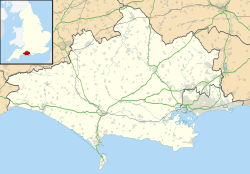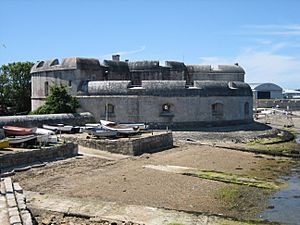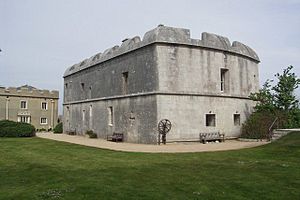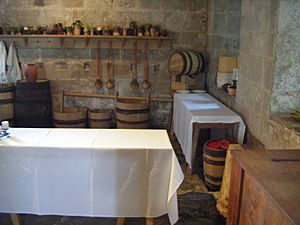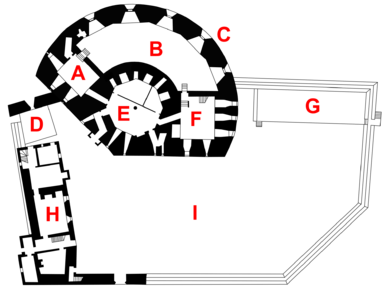Portland Castle facts for kids
Quick facts for kids Portland Castle |
|
|---|---|
| Dorset, England | |
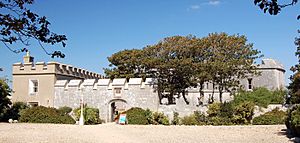
The entrance to the outer courtyard
|
|
| Coordinates | 50°34′06″N 02°26′48″W / 50.56833°N 2.44667°W |
| Type | Device Fort |
| Site information | |
| Owner | English Heritage |
| Open to the public |
Yes |
| Condition | Intact |
| Site history | |
| Built | 1539–41 |
| In use | 1949 |
| Materials | Portland stone |
| Events | English Civil War First Anglo-Dutch War |
| Official name | Portland Castle |
| Designated | 9 October 1981 |
| Reference no. | 1015326 |
|
Listed Building – Grade I
|
|
| Official name | Portland Castle |
| Designated | 17 May 1993 |
| Reference no. | 1205262 |
Portland Castle is a strong fort built by King Henry VIII on the Isle of Portland, Dorset, in England. It was constructed between 1539 and 1541. This castle was part of the King's plan to protect England from possible attacks by France and the Holy Roman Empire. It guarded the important Portland Roads anchorage, which was a safe place for ships to stop.
The castle has a unique fan shape and was built using local Portland stone. It features a curved central tower and a special area for cannons, with two angled sections on its sides. Soon after it was built, it had eleven cannons ready to fire at enemy ships. Portland Castle worked together with Sandsfoot Castle, located on the other side of the anchorage, to defend the area.
During the English Civil War, supporters of King Charles I (called Royalists) took control of Portland Castle. It survived two attacks before finally surrendering to the Parliament's forces (called Roundheads) in 1646.
Portland Castle continued to be used as a fort until the end of the Napoleonic Wars in 1815. After that, it was turned into a private home. However, worries about new invasions led the army to take it over again in 1869. The castle wasn't rearmed but was used to house soldiers from nearby, more modern forts. During the First World War and Second World War, it served as offices, living quarters, and a place to store ammunition.
In 1949, the army gave up control of the castle. In 1955, it was opened to the public. Today, English Heritage manages Portland Castle as a popular tourist spot. In 2010, over 22,000 people visited, and in 2023, it welcomed 30,000 visitors, its highest number ever. Experts at Historic England consider Portland Castle to be "one of the best preserved and best known examples" of King Henry's forts.
Contents
History of Portland Castle
Building the Castle (16th Century)
Portland Castle was built because of big disagreements between England, France, and the Holy Roman Empire during the last years of King Henry VIII's rule. Before this, England's kings usually let local leaders and communities handle coastal defenses. The king only played a small part in building forts. While France and the Empire were fighting each other, raids by sea were common, but a full invasion of England seemed unlikely. There were some basic defenses, like simple blockhouses and towers, but most forts were very small.
In 1533, King Henry VIII decided to end his marriage to Catherine of Aragon. This made Charles V, the Holy Roman Emperor (who was Catherine's nephew), very angry. In 1538, France and the Empire formed an alliance against Henry, and the Pope encouraged them to attack England. It looked like an invasion of England was definitely going to happen.
To prepare, King Henry issued an order in 1539. This order, called a "device", gave instructions for "defending the country in time of invasion." It called for building forts all along the English coastline.
Because of this order, Lord Russell checked the coast around an area called Portland Roads. He decided that two castles, Portland and Sandsfoot, should be built to protect it from naval attacks. Work on Portland Castle started that summer and was finished by 1541. It cost about £4,964, which was a lot of money back then.
Thomas Mervin became the first captain, with a small group of four gunners and two other men. In 1545, John Leweston took over as captain and also became the Lieutenant of Portland. The castle's team grew to 13 men, paid for with money from the recent closing of monasteries. A report from 1547-1548 showed the castle had many cannons and other weapons, like bows and arrows.
The danger of a French invasion passed, and peace was declared in 1558. People paid less attention to Portland Castle. Reports in 1574 and 1583 said the castle was in poor condition. But then, tensions with Spain grew, and military focus shifted to protecting the southwest of England. A war started in 1585, and £228 was spent to fix up Portland Castle. By 1596, it still had a captain and 13 men guarding it.
Later Years (17th to 19th Centuries)
In the early 1600s, England was at peace, so coastal forts like Portland Castle were not a top priority. A 1623 report said the castle had several cannons, but its defenses were damaged by the sea and needed many repairs. Fourteen years later, the castle had 15 guns and a team of a captain and 12 men.
When the English Civil War began in 1642, Portland Castle was first held by Parliament's forces. However, in 1643, Royalist supporters of the King captured it by pretending to be Parliament soldiers. As the war turned against the King in the southwest, Parliament's forces attacked the castle twice, once in 1644 and again the next year. The castle finally surrendered in April 1646. It's not clear why the castle, which wasn't easy to defend from the land side, was so hard to capture. Some historians think its low position might have made it difficult for Parliament to attack it from the sea.
After the Civil War, Portland Castle continued to have soldiers and was used as a prison. It helped defend Portland Roads during a naval battle in 1653 between English and Dutch forces. When King Charles II returned to the throne in 1660, he reduced the number of soldiers but repaired the castle because of the ongoing threat from the Dutch. By 1676, the castle had 16 guns.
Portland Castle remained in use throughout the 1700s, mainly protecting ships from privateers (pirates working for a government). Reports in 1702 and 1715 complained that the fort was falling apart, with the sea washing away parts of its foundations. The number of cannons was reduced to seven. By 1779, the castle had only three caretakers and eight guns, and it hadn't been repaired in 30 years. During the Napoleonic Wars, the castle's guns were increased, but the fort was still in poor condition.
After Napoleon's final defeat, the castle's guns were removed. It was then rented to John Manning, a local churchman, who turned it from a fort into a private home. His son, Charles Manning, continued to improve the house. They also changed an older house next to the castle, which used to be for the master gunner, into a grander home now called the Captain's House. In the late 1840s, Portland Harbour was created by building a large breakwater. New forts were built on the Verne heights and along the seafront to protect it. Charles Manning died in 1869. With new fears of invasion, the army took over the castle again to house officers.
Modern Times (20th and 21st Centuries)
In the early 1900s, the army and the Office of Works discussed how to manage the castle. In 1908, Portland Castle was put on a special list. This meant the army would keep using and managing the historic property, but the Office of Works would help with repairs. When the First World War started in 1914, Portland Harbour became a very important naval base. The castle was used to store ammunition.
Between the two World Wars, the castle became a military home again. During the Second World War, British and US soldiers used it for living quarters and offices. Part of the castle was also used to store ammunition once more. A concrete pillbox, a small defensive structure, was built next to the castle early in the war, but it has since been removed.
After the war, Portland Castle was given to the Ministry of Works in 1949. It opened to the public in 1955. The Ministry decided to make the inside look like it did in the 1500s. They removed most of the changes made in the 1800s and 1900s. The Captain's House and the gardens next to it were used by the nearby helicopter base, HMS Osprey, until 1999. When the base closed, this part of the fort also opened to visitors, and the house became a visitor center.
Today, English Heritage runs Portland Castle as a tourist attraction. The main castle is protected by UK law as a Grade I listed building, meaning it's a very important historic site. The Captain's House is also protected as a Grade II* building.
Castle Design and Features
The main part of Portland Castle is its central tower, called the keep. It is about 120 feet (37 meters) wide. The keep has a central tower with two wings on each side and a cannon area at the front. Together, these parts form an unusual fan shape that looks out over the sea.
A walled courtyard surrounds the keep, measuring about 170 by 90 feet (52 by 27 meters). There are two cannon platforms on either side of the keep. The Captain's House is on the western side of the courtyard, and the Governor's Garden is beyond the eastern wall. You enter the castle through an outer gate on the south side, which has King Charles II's coat of arms above it.
When it was first built, the castle would have had three levels of cannons. Two levels were in the front cannon area, and a third level was in the central tower. The keep was originally protected by a moat, which was a ditch filled with water. The moat has since been filled in, but you can still see the slots where a drawbridge used to be. The castle also had small openings for hand guns to protect it up close. A moated earthwork (a defensive mound of earth) was later built behind the castle for extra protection.
The keep is two stories tall and built from finely cut Portland stone. Historic England says it is "one of the best preserved and best known examples" of King Henry's forts. In the center of the ground floor is the octagonal (eight-sided) great hall. This hall now has large Victorian windows, but it was originally the living space for the soldiers. Off the great hall are wings that held the gunners' quarters and the castle's kitchen. The kitchen still has a large fireplace from the 1500s.
The gun room runs along the front of the keep. This was originally a two-story cannon battery. It had openings for five cannons on the ground floor and four more on the first floor. The ground-floor openings had vents to let the smoke from the cannons escape. The wooden roof that formed the first-floor cannon platform and the inside wooden walls have been removed. Now, the chamber is open to the air and holds various cannons from the 1700s and 1800s.
On the first floor, you'll find the upper hall and the captain's chamber. In the 1500s, the castle's commander used this area for living and working. In the 1800s, it was changed into a dining room and a bedroom. On the opposite side of the captain's private room are two other bedrooms, possibly for the castle's lieutenant.
The current Governor's Garden was created in 2002 by a gardener named Christopher Bradley-Hole. This was part of a bigger project across English Heritage properties. The garden has a sea theme, with circular designs that match those in the castle. It also uses local Portland stone.
Images for kids
See also
 In Spanish: Castillo de Pórtland para niños
In Spanish: Castillo de Pórtland para niños


